change time SATURN ION 2007 User Guide
[x] Cancel search | Manufacturer: SATURN, Model Year: 2007, Model line: ION, Model: SATURN ION 2007Pages: 440, PDF Size: 2.93 MB
Page 225 of 440
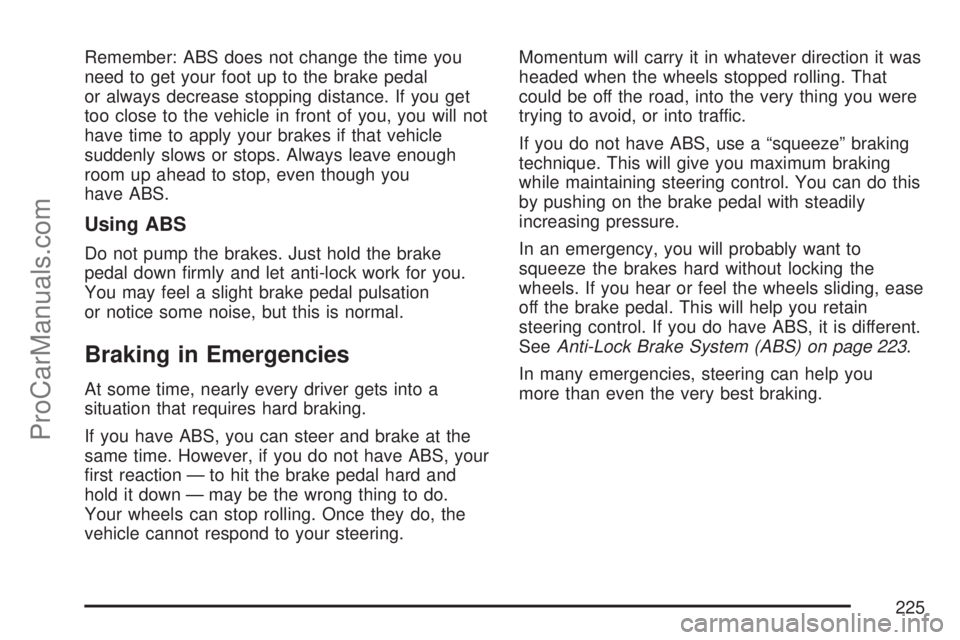
Remember: ABS does not change the time you
need to get your foot up to the brake pedal
or always decrease stopping distance. If you get
too close to the vehicle in front of you, you will not
have time to apply your brakes if that vehicle
suddenly slows or stops. Always leave enough
room up ahead to stop, even though you
have ABS.
Using ABS
Do not pump the brakes. Just hold the brake
pedal down �rmly and let anti-lock work for you.
You may feel a slight brake pedal pulsation
or notice some noise, but this is normal.
Braking in Emergencies
At some time, nearly every driver gets into a
situation that requires hard braking.
If you have ABS, you can steer and brake at the
same time. However, if you do not have ABS, your
�rst reaction — to hit the brake pedal hard and
hold it down — may be the wrong thing to do.
Your wheels can stop rolling. Once they do, the
vehicle cannot respond to your steering.Momentum will carry it in whatever direction it was
headed when the wheels stopped rolling. That
could be off the road, into the very thing you were
trying to avoid, or into traffic.
If you do not have ABS, use a “squeeze” braking
technique. This will give you maximum braking
while maintaining steering control. You can do this
by pushing on the brake pedal with steadily
increasing pressure.
In an emergency, you will probably want to
squeeze the brakes hard without locking the
wheels. If you hear or feel the wheels sliding, ease
off the brake pedal. This will help you retain
steering control. If you do have ABS, it is different.
SeeAnti-Lock Brake System (ABS) on page 223.
In many emergencies, steering can help you
more than even the very best braking.
225
ProCarManuals.com
Page 232 of 440

When it looks like a chance to pass is coming
up, start to accelerate but stay in the right lane
and do not get too close. Time your move so
you will be increasing speed as the time comes
to move into the other lane. If the way is clear to
pass, you will have a running start that more
than makes up for the distance you would lose
by dropping back. And if something happens to
cause you to cancel your pass, you need only
slow down and drop back again and wait for
another opportunity.
If other vehicles are lined up to pass a slow
vehicle, wait your turn. But take care that
someone is not trying to pass you as you pull
out to pass the slow vehicle. Remember to
glance over your shoulder and check the
blind spot.
Check your vehicle’s mirrors, glance over your
shoulder, and start your left lane change signal
before moving out of the right lane to pass.
When you are far enough ahead of the passed
vehicle to see its front in your vehicle’s inside
mirror, activate the right lane change signal and
move back into the right lane. Remember that
your vehicle’s passenger side outside mirror is
convex. The vehicle you just passed may seem
to be farther away from you than it really is.
Try not to pass more than one vehicle at a time
on two-lane roads. Reconsider before passing
the next vehicle.
Do not overtake a slowly moving vehicle too
rapidly. Even though the brake lamps are not
�ashing, it may be slowing down or starting
to turn.
If you are being passed, make it easy for the
following driver to get ahead of you. Perhaps
you can ease a little to the right.
232
ProCarManuals.com
Page 259 of 440
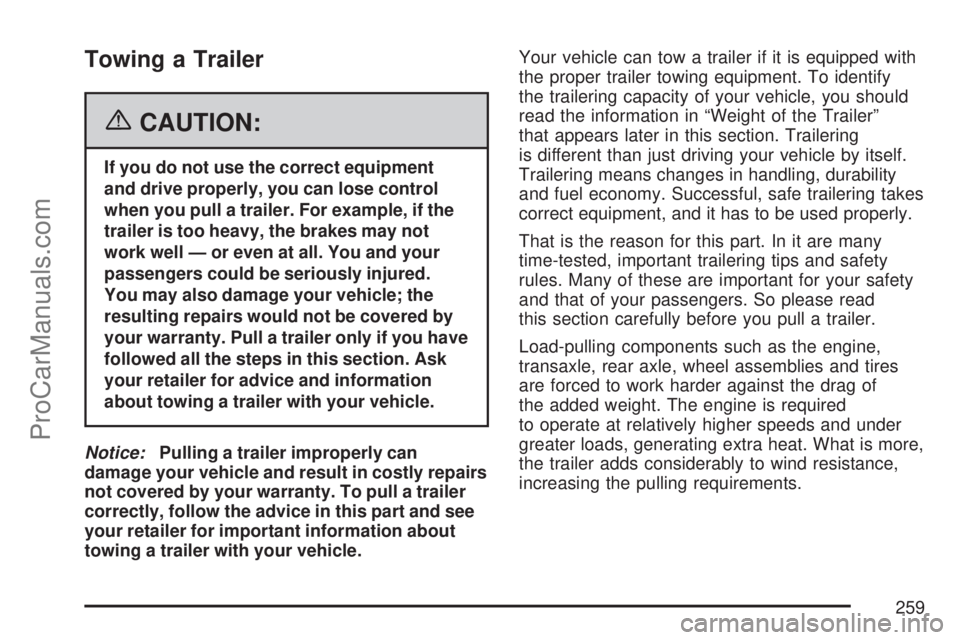
Towing a Trailer
{CAUTION:
If you do not use the correct equipment
and drive properly, you can lose control
when you pull a trailer. For example, if the
trailer is too heavy, the brakes may not
work well — or even at all. You and your
passengers could be seriously injured.
You may also damage your vehicle; the
resulting repairs would not be covered by
your warranty. Pull a trailer only if you have
followed all the steps in this section. Ask
your retailer for advice and information
about towing a trailer with your vehicle.
Notice:Pulling a trailer improperly can
damage your vehicle and result in costly repairs
not covered by your warranty. To pull a trailer
correctly, follow the advice in this part and see
your retailer for important information about
towing a trailer with your vehicle.Your vehicle can tow a trailer if it is equipped with
the proper trailer towing equipment. To identify
the trailering capacity of your vehicle, you should
read the information in “Weight of the Trailer”
that appears later in this section. Trailering
is different than just driving your vehicle by itself.
Trailering means changes in handling, durability
and fuel economy. Successful, safe trailering takes
correct equipment, and it has to be used properly.
That is the reason for this part. In it are many
time-tested, important trailering tips and safety
rules. Many of these are important for your safety
and that of your passengers. So please read
this section carefully before you pull a trailer.
Load-pulling components such as the engine,
transaxle, rear axle, wheel assemblies and tires
are forced to work harder against the drag of
the added weight. The engine is required
to operate at relatively higher speeds and under
greater loads, generating extra heat. What is more,
the trailer adds considerably to wind resistance,
increasing the pulling requirements.
259
ProCarManuals.com
Page 288 of 440
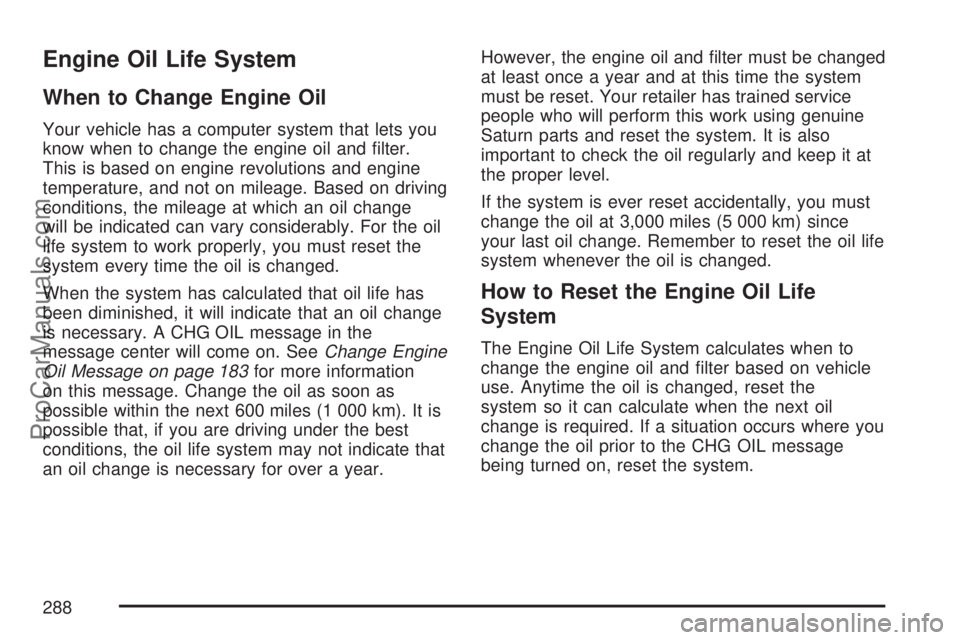
Engine Oil Life System
When to Change Engine Oil
Your vehicle has a computer system that lets you
know when to change the engine oil and �lter.
This is based on engine revolutions and engine
temperature, and not on mileage. Based on driving
conditions, the mileage at which an oil change
will be indicated can vary considerably. For the oil
life system to work properly, you must reset the
system every time the oil is changed.
When the system has calculated that oil life has
been diminished, it will indicate that an oil change
is necessary. A CHG OIL message in the
message center will come on. SeeChange Engine
Oil Message on page 183for more information
on this message. Change the oil as soon as
possible within the next 600 miles (1 000 km). It is
possible that, if you are driving under the best
conditions, the oil life system may not indicate that
an oil change is necessary for over a year.However, the engine oil and �lter must be changed
at least once a year and at this time the system
must be reset. Your retailer has trained service
people who will perform this work using genuine
Saturn parts and reset the system. It is also
important to check the oil regularly and keep it at
the proper level.
If the system is ever reset accidentally, you must
change the oil at 3,000 miles (5 000 km) since
your last oil change. Remember to reset the oil life
system whenever the oil is changed.
How to Reset the Engine Oil Life
System
The Engine Oil Life System calculates when to
change the engine oil and �lter based on vehicle
use. Anytime the oil is changed, reset the
system so it can calculate when the next oil
change is required. If a situation occurs where you
change the oil prior to the CHG OIL message
being turned on, reset the system.
288
ProCarManuals.com
Page 289 of 440
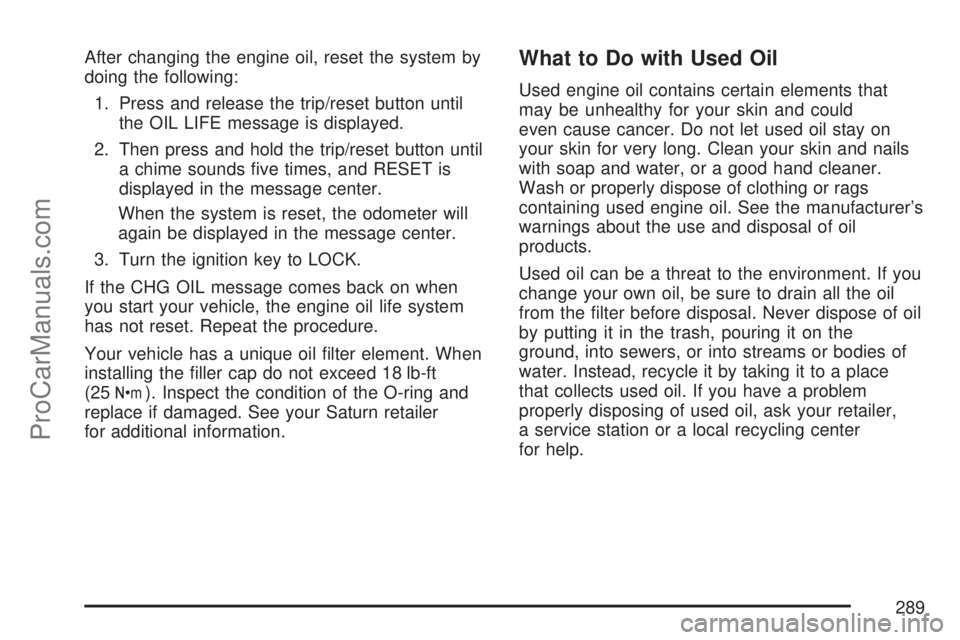
After changing the engine oil, reset the system by
doing the following:
1. Press and release the trip/reset button until
the OIL LIFE message is displayed.
2. Then press and hold the trip/reset button until
a chime sounds �ve times, and RESET is
displayed in the message center.
When the system is reset, the odometer will
again be displayed in the message center.
3. Turn the ignition key to LOCK.
If the CHG OIL message comes back on when
you start your vehicle, the engine oil life system
has not reset. Repeat the procedure.
Your vehicle has a unique oil �lter element. When
installing the �ller cap do not exceed 18 lb-ft
(25
Y). Inspect the condition of the O-ring and
replace if damaged. See your Saturn retailer
for additional information.
What to Do with Used Oil
Used engine oil contains certain elements that
may be unhealthy for your skin and could
even cause cancer. Do not let used oil stay on
your skin for very long. Clean your skin and nails
with soap and water, or a good hand cleaner.
Wash or properly dispose of clothing or rags
containing used engine oil. See the manufacturer’s
warnings about the use and disposal of oil
products.
Used oil can be a threat to the environment. If you
change your own oil, be sure to drain all the oil
from the �lter before disposal. Never dispose of oil
by putting it in the trash, pouring it on the
ground, into sewers, or into streams or bodies of
water. Instead, recycle it by taking it to a place
that collects used oil. If you have a problem
properly disposing of used oil, ask your retailer,
a service station or a local recycling center
for help.
289
ProCarManuals.com
Page 311 of 440
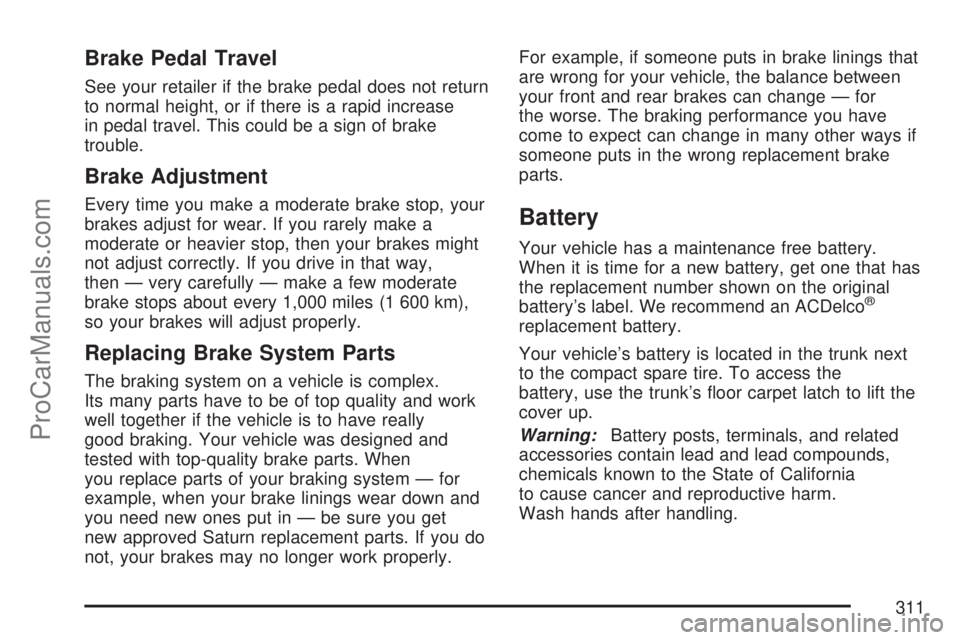
Brake Pedal Travel
See your retailer if the brake pedal does not return
to normal height, or if there is a rapid increase
in pedal travel. This could be a sign of brake
trouble.
Brake Adjustment
Every time you make a moderate brake stop, your
brakes adjust for wear. If you rarely make a
moderate or heavier stop, then your brakes might
not adjust correctly. If you drive in that way,
then — very carefully — make a few moderate
brake stops about every 1,000 miles (1 600 km),
so your brakes will adjust properly.
Replacing Brake System Parts
The braking system on a vehicle is complex.
Its many parts have to be of top quality and work
well together if the vehicle is to have really
good braking. Your vehicle was designed and
tested with top-quality brake parts. When
you replace parts of your braking system — for
example, when your brake linings wear down and
you need new ones put in — be sure you get
new approved Saturn replacement parts. If you do
not, your brakes may no longer work properly.For example, if someone puts in brake linings that
are wrong for your vehicle, the balance between
your front and rear brakes can change — for
the worse. The braking performance you have
come to expect can change in many other ways if
someone puts in the wrong replacement brake
parts.
Battery
Your vehicle has a maintenance free battery.
When it is time for a new battery, get one that has
the replacement number shown on the original
battery’s label. We recommend an ACDelco
®
replacement battery.
Your vehicle’s battery is located in the trunk next
to the compact spare tire. To access the
battery, use the trunk’s �oor carpet latch to lift the
cover up.
Warning:Battery posts, terminals, and related
accessories contain lead and lead compounds,
chemicals known to the State of California
to cause cancer and reproductive harm.
Wash hands after handling.
311
ProCarManuals.com
Page 322 of 440
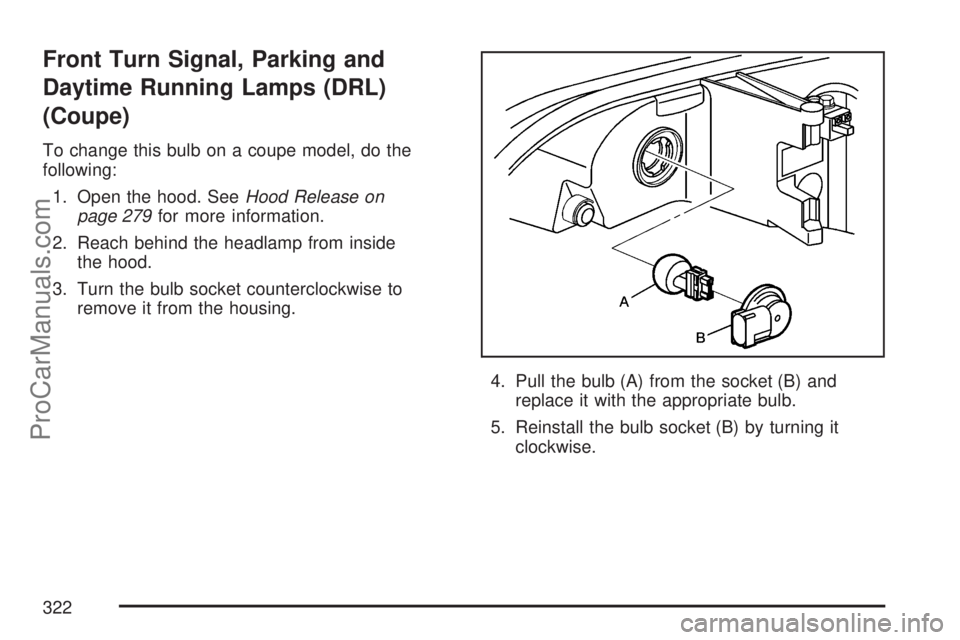
Front Turn Signal, Parking and
Daytime Running Lamps (DRL)
(Coupe)
To change this bulb on a coupe model, do the
following:
1. Open the hood. SeeHood Release on
page 279for more information.
2. Reach behind the headlamp from inside
the hood.
3. Turn the bulb socket counterclockwise to
remove it from the housing.
4. Pull the bulb (A) from the socket (B) and
replace it with the appropriate bulb.
5. Reinstall the bulb socket (B) by turning it
clockwise.
322
ProCarManuals.com
Page 323 of 440

Front Turn Signal, Parking and
Daytime Running Lamps (DRL)
(Sedan)
To change this bulb on a sedan model, do the
following:
1. Follow Steps 1 through 4 to remove the
headlamp assembly. See the headlamp
removal for sedan underHeadlamps (Coupe)
on page 319orHeadlamps (Sedan) on
page 320. This bulb is located next to the
high/low-beam headlamp.
2. Remove the bulb socket (B) by turning it
counterclockwise.
3. Remove the bulb (A) and replace it with the
appropriate bulb.
4. Reverse the steps to reinstall the lamp
assembly.
323
ProCarManuals.com
Page 340 of 440

If your vehicle has 215/45ZR17 size tires, they are
directional tires and must roll in a certain direction
for the best overall performance. The direction is
shown by an arrow on the tire sidewall. Because
these tires are directional, they should be rotated as
shown here. These tires should only be moved from
front to rear and rear to front on the same side of
the vehicle.
Do not include the compact spare tire in your tire
rotation.After the tires have been rotated, adjust the front
and rear in�ation pressures as shown on the
Tire and Loading Information label. SeeLoading
Your Vehicle on page 250for an example of
the tire and loading information label and
its location on your vehicle. Make certain that all
wheel nuts are properly tightened. See “Wheel Nut
Torque” underCapacities and Speci�cations on
page 384.
{CAUTION:
Rust or dirt on a wheel, or on the parts to
which it is fastened, can make wheel bolts
become loose after a time. The wheel
could come off and cause an accident.
When you change a wheel, remove any
rust or dirt from places where the wheel
attaches to the vehicle. In an emergency,
you can use a cloth or a paper towel to do
this; but be sure to use a scraper or wire
brush later, if you need to, to get all the
rust or dirt off. SeeChanging a Flat Tire
on page 350.Directional Tires
340
ProCarManuals.com
Page 359 of 440

6. Remove all of the
wheel nuts.
{CAUTION:
Rust or dirt on the wheel, or on the parts
to which it is fastened, can make the
wheel nuts become loose after time.
The wheel could come off and cause an
accident. When you change a wheel,
remove any rust or dirt from the places
where the wheel attaches to the vehicle.
CAUTION: (Continued)
CAUTION: (Continued)
In an emergency, you can use a cloth or a
paper towel to do this; but be sure to use
a scraper or wire brush later, if needed, to
get all the rust or dirt off.
7. Remove any rust or
dirt from the wheel
bolts, mounting
surfaces and spare
wheel.
8. Place the compact spare tire on the
wheel-mounting surface.
359
ProCarManuals.com